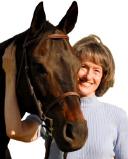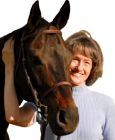Body Language
Cross-Species Communication in Olympic Dressage
How horses and riders interact during "horse ballet."
Posted July 27, 2021 Reviewed by Jessica Schrader
Key points
- The Olympic Dressage at Tokyo 2020 is a good example of horse-and-human communication.
- Horse and human brains are interacting in real time, brain to brain, in performance events.
- Horses and humans communicate with no mediation from language or speech, but in a more direct and natural way.

Horse-and-human communication is at its best in performance horsemanship. What’s that? Well, an outstanding example has been happening this week in Tokyo, with the 2020 Olympic Equestrian events. Have a look at some of the winning dressage horse-and-human teams. If you have a chance, tomorrow’s Grand Prix Freestyle will be a stunning example. Watch it in on TV or search YouTube for video clips of the winners.
Dressage has been called “horse ballet” because the horse appears to dance in complex steps and sequences all across an arena. These horses and riders are very highly trained, of course, and equestrian events are the only sports in which males and females of all ages compete head to head. A really good team displays what the Italians call “sprezzatura”—the art of making the extremely difficult look simple.
Most people who watch dressage do not see the rider’s movements that tell the horse what to do. Imperceptible cueing is the sign of an excellent rider and a highly trained horse. But how do we convey to a prey animal that we want him to cross his front legs and canter sideways? Or trot in place?
Despite their immense size, horses are extremely sensitive to touch and body language. For example, the average horse has greater capacity to feel tiny pressures on his skin than the average human does even on her fingertips. The average horse notices a human rider’s precise body position and infinitesimal shifts in balance. He picks up differences in human weight distribution that other species would never know occurred.
So, when a rider presses a leg gently against a horse’s side, the horse feels it. We train horses to associate human cues like this with equine action. The touch of a left leg against the horse’s left side, for example, tells the horse to move to the right. Feeling this touch, the well-trained horse will instantly move rightward. And so on, for every part of the horse-and-human team’s two bodies.
Horse-and-human communication also depends on context. The left leg pressure that tells a horse to move to the right can have other meanings, too. Sometimes, it tells the horse to pick up a canter. Other times, it tells the horse to turn right, or to make an arc around the left leg, or … Well, you get the idea. My point is that the context in which a rider supplies a cue tells the horse just as much as the cue itself. Pretty complicated stuff.
Let’s look at this form of communication in a little more detail. The horse’s skin and muscles contain receptor cells that are specialized to pick up feelings of slight pressure. These tiny receptors send impulses to the horse’s peripheral nerves and on to his spinal cord. From there, they are transmitted to his brain.
The horse’s brain has been taught that a particular feeling in a particular location has a meaning. It might mean move left, or right, go forward, go faster, go slower, stop, reverse, turn, or any number of things. When the receptor cell’s information reaches the horse’s brain, he will perform whichever of these movements he has been trained to produce in the context of the request.
The horse’s responding movement has its effect on the human rider, too. Instigated by the equine brain, it travels down his spinal cord to his muscles and joints—where the motion occurs. Human riders have tiny receptors in their skin, muscles, and joints. So they feel the horse’s response in their bodies when impulses from their human receptor cells reach their human brains.
Done once or twice, this isn’t such a big deal. But when we watch horses and riders perform in team efforts like Olympic-level dressage, the neural communication between the two species is occurring in real time over a period of several minutes. Millions of messages are being transmitted back and forth, with the horse’s brain and the human’s brain interacting like one well-oiled machine. I really mean “one”! The joint interaction back and forth between equine and human neurons creates the feeling of a prey animal and a predator having only one brain between them.
Now… may I say, this is rare. How often can you crawl into the brain of another animal and put it to use with your own? I can’t think of another example. Sled dogs compete with human help and must interact on a regular basis. But we don’t ride sled dogs. Much of our performance communication with them is based on human language. The dogs have learned to associate certain movements with the humans’ spoken words. Remarkable, indeed.
But it’s nowhere near as remarkable as the communication between horse and human that occurs without mediation from language or speech. Watch that dressage competition again: Not a word is spoken, not a single noise is made between horse and human. The tack—saddle and bridle—is largely a formality to help the rider maintain position. Horses and riders communicate even more closely via body language without saddles, when their bodies are in direct contact with each other. And bridles? We’ll get to that in another post when we consider bridle-less performance competitions.
In horse-and-human communication, the horse is allowed to communicate in nature’s way, by virtue of his brain. He does not have to learn verbal commands that interfere with his brain’s normal means of doing business. And the human rider communicates via body language that the horse is uniquely suited to receive. Please, take three minutes of your busy day and watch a video clip of this week’s Olympic dressage competition. (They’re like potato chips, you can’t watch just one … but start with one!) While you watch, think about the intense brain-to-brain communication going on in front of your eyes, between a prey animal and a human being.




